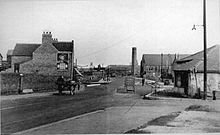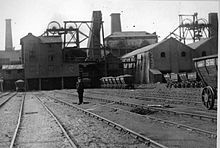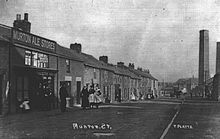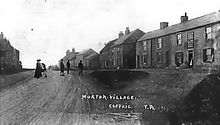- Murton, County Durham
-
Coordinates: 54°49′N 1°25′W / 54.82°N 1.42°W
Murton 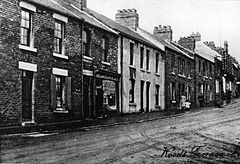
Woods Terrace, Murton, in around 1907
 Murton shown within County Durham
Murton shown within County DurhamPopulation 7,339 (2001 Census) OS grid reference NZ323702 Unitary authority County Durham Ceremonial county County Durham Region North East Country England Sovereign state United Kingdom Post town SEAHAM Postcode district SR7 Dialling code 0191 Police Durham Fire County Durham and Darlington Ambulance North East EU Parliament North East England UK Parliament Easington List of places: UK • England • County Durham Murton is a village in County Durham, England. Lying six miles (9.6 km) east of the city of Durham and seven miles (11.25 km) south of Sunderland, it has a population of 7,339.[1]
Originally a rural agricultural hamlet called Morton,[2] the discovery of coal beneath its fields in the 19th century transformed it into an industrial community.[2] 'Morton became known as Murton Colliery or Murton-in-the-Whins[3] following the sinking of the pit in 1838 by South Hetton Coal Company,[4] and the village was a productive coal mining community for over a century. The pit employed over 1000 men at its peak and featured in a Picture Post article showing the 'vesting' of the mine at nationalisation in 1947.[5]
The village also had the South East Durham Cooperative Bakery and a Northern Bus Company garage as added sources of jobs. In 1955 a by product works for coal was established for the production mainly of coke. The mine and other employment opportunities closed in the 1990s along with many other County Durham mines and now the old spoil heaps are host to a retail outlet development Dalton Park, bringing much needed new employment.
Contents
History
Further information: History of County DurhamThe discovery of coal beneath the fields of East Durham during the 19th century, transformed the tiny hamlet of Morton into the thriving township of Murton.
Decades later, however, the decision to close Murton's successful colliery almost, but not quite, succeeded in turning the close-knit community into a ghost town. Millions of pounds in Government and private investment is now being pumped into Murton, changing the face of the former pit village on an almost daily basis.
Fewer than 100 people lived in the village of Murton before 1830 but, following the sinking of the mine in 1838, the population grew to 1,387 by 1851. Miners flocked to Murton from across County Durham and Northumberland in the early years, with people later uprooting from Devon, Cornwall and Ireland too. Many of the road and place names reflected the original roots of these pitmen, like the Cornwall estate, and dozens of different accents could be heard in the streets.
Work on the colliery – one of the pioneering mines of the East Durham coalfield, began on February 19, 1838, but it was five years before the first coals were drawn. Problems with pockets of shifting sand and the depth of the magnesium limestone overlying the coal delayed the work, making the project hugely expensive. Late shifts were even introduced for the first time, so that excavation could be carried out around the clock to finish the three-shafted pit as quickly as possible.
Just five years after the colliery opened, however, there was an explosion on August 15, 1848, near the Polka East shaft, which killed 14 miners. The tragedy left villagers shaken, but the village itself continued to flourish. Indeed, by 1856 Murton was almost unrecognisable from the hamlet it had once been. Scores of terraced houses had been built to house the miners and the village now boasted three pubs, a new school, plus gas and coke works. As prospective miners continued to flood in, so the number of tradesmen grew, with Murton Colliery Co-operative Society helping to serve the village by 1890.
As the village flourished, so too did the colliery. It was modernised after World War I and, in 1922, a Koepe friction winding engine was installed in the West Pit. New pithead baths followed in 1939, described as being "of especially pleasant design," and Murton's swimming pool was opened in 1961.
But, despite high productivity and a loyal workforce, the decision was taken to close the pit in 1991. Campaigners fought against the plans, but failed to stop them. The Koepe winding engine was transferred to the Bowes Railway following the controversial closure and, in 1994, the colliery's winding tower was demolished. Murton's once-thriving pit community was now no more.
Timeline
1830: Population 69
1838: Work on pit starts
1843: First coals drawn
1851: Population 1,395
1889: Electricity first used in pit
1892: Murton toll gates removed
1902: Three putters killed in pit, two aged 14, one aged 18
1906: Colliery draws 4,131 tons of coal in one day
1910: Miners strike over Eight Hours Bill
1913: Foundation stone laid for first council house
1914: First public telephone for Murton, based in post office
1922: Cenotaph unveiled
1923: Coal drawn from West Pit for first time
1927: Bus service to Sunderland introduced by Northern buses
1930: First "talking pictures" at Murton Empire
1931: Flush toilets put in colliery houses
1935: Miners started carrying electric lamps
1939: Pit head baths opened
1950: X-ray van visited Murton for the first time
1953: The first paid annual holiday leave of two weeks was introduced
1957: A new library was opened in Barnes Road
1958: Murton Brickworks closed
1961: Murton's swimming pool was opened
1982: First memorial service held to commemorate fatalities at Murton pit
1990: Miners fought to keep the pit open
1991: Murton Colliery was closed
1994: Pit winding tower demolished, despite being listed
Geography
Climate
Murton Climate chart (explanation) J F M A M J J A S O N D 566139715192521135015655179452011612011581795713662935972Average max. and min. temperatures in °C Precipitation totals in mm Source: [6] Imperial conversion J F M A M J J A S O N D 2.243331.5443324836252381.958422.263471.868512.467512.362472.255432.448382.34535Average max. and min. temperatures in °F Precipitation totals in inches Like the rest of the United Kingdom, Murton has a temperate climate. At 643.3 millimetres (25 in)[6] the average annual rainfall is lower than the national average of 1,125 millimetres (44 in).[7] Equally there are only around 121.3 days[6] where more than 1 millimetre (0.04 in) of rain falls compared with a national average of 154.4 days.[7] The area sees on average 1374.6 hours of sunshine per year,[6] compared with a national average of 1125.0 hours.[7] There is frost on 52 days[6] compared with a national average of 55.6 days.[7] Average daily maximum and minimum temperatures are 12.5 °C (54.5 °F) and 5.2 °C (41.4 °F)[6] compared with a national averages of 12.1 °C (53.8 °F) and 5.1 °C (41.2 °F) respectively.[7]
The table below gives the average temperature and rainfall figures taken between 1971 and 2000 at the Met Office weather station in Durham:
Climate data for Durham 102m asl, 1971-2000, extremes 1850- Month Jan Feb Mar Apr May Jun Jul Aug Sep Oct Nov Dec Year Record high °C (°F) 16.7
(62.1)16.8
(62.2)21.7
(71.1)24.1
(75.4)27.8
(82.0)30.6
(87.1)31.7
(89.1)32.5
(90.5)30.0
(86.0)25.0
(77.0)19.4
(66.9)15.1
(59.2)32.5
(90.5)Average high °C (°F) 6.2
(43.2)6.7
(44.1)9.0
(48.2)11.2
(52.2)14.5
(58.1)17.2
(63.0)19.8
(67.6)19.6
(67.3)16.7
(62.1)13
(55)9.0
(48.2)7.0
(44.6)12.5 Average low °C (°F) 0.6
(33.1)0.8
(33.4)2.1
(35.8)3.3
(37.9)5.7
(42.3)8.5
(47.3)10.7
(51.3)10.6
(51.1)8.6
(47.5)6.0
(42.8)3.1
(37.6)1.5
(34.7)5.2 Record low °C (°F) −17.2
(1.0)−18.3
(−0.9)−15
(5)−11.1
(12.0)−4.4
(24.1)−1.1
(30.0)1.1
(34.0)0.6
(33.1)−1.1
(30.0)−5.5
(22.1)−8.8
(16.2)−16.6
(2.1)−18.3
(−0.9)Rainfall mm (inches) 56.2
(2.213)38.8
(1.528)51.1
(2.012)52.0
(2.047)49.5
(1.949)54.8
(2.157)44.5
(1.752)61.3
(2.413)57.5
(2.264)56.9
(2.24)61.5
(2.421)59.2
(2.331)643.3
(25.327)Sunshine hours 55.2 70.9 106.6 134.4 174.8 160.8 168.0 167.4 126.3 97.0 66.6 46.5 1,374.6 Source no. 1: Met Office Source no. 2: NEForum Old village streets and their nicknames
Owen Street: Sandgate Rar
Lancaster Street: Double Rar
Green Street: Smokey Rar
Railway Street: Red Tiled Rar
Villiers Street: Wood Rar
Durham Place: Sinkers Rar
Dalton Terrace: Pot Pie Rar
South Street: Plantation Rar
East Street: Cinder Burners Rar
Shipperdon Street: Ower the Field
Murton Street: Cross Rar
Old Pilgrim Street: Boiler Rar
New Pilgrim Street: Low Rar
Pilgrim Street: High Rar
Model Street: Wagon Rar
Economy
This is a chart of trend of regional gross value added of County Durham at current basic prices published (pp. 240-253) by Office for National Statistics with figures in millions of British Pounds Sterling.
Year Regional Gross Value Added[8] Agriculture[9] Industry[10] Services[11] 1995 4,063 47 1,755 2,261 2000 4,783 40 1,840 2,904 2003 5,314 39 1,978 3,297 Notable inhabitants
- Ernest Williamson - Professional footballer
- George Liddell - Professional footballer and football club manager
- James Hall DCM, MM - World War One soldier
- Joe Shaw (footballer born 1928) - Professional footballer
- John Cummings (politician) - Former miner, was MP for Easington until 2010
- Mary Ann Cotton - First British female serial killer
- Michael Murphy (VC) - Won the Victoria Cross
- Paul Kitson - Professional footballer
- William McNally - Won the Victoria Cross in World War One
- Dave Harper - Drummer for pop group Frankie & The Heartstrings
See also
- Durham
- Seaham
- Durham Miners' Gala
- Sunderland, Tyne and Wear
- Dawdon
- Easington
References
- ^ British Government. "Office for Statistics: Area: Murton East (Ward)". Office for National Statistics. http://neighbourhood.statistics.gov.uk/dissemination/LeadDatasetList.do?a=3&b=5947301&c=murton&d=14&g=440429&i=1001x1003&m=0&r=1&s=1208622504150&enc=1&domainId=16. Retrieved 2008-03-30.
- ^ a b Durham County Council. "Durham Records Inline Murton (East Murton)". Durham Records Office. http://www.durhamrecordsonline.com/literature/murton.php. Retrieved 2008-03-30.
- ^ Paul R. Joiner. "GenukI Dalton-le-Dale". GENUKI. http://www.joinermarriageindex.com/pjoiner/genuki/DUR/DaltonleDale/index.html. Retrieved 2008-03-30.
- ^ Whellan's 1894 Directory of County Durham. "Murton Colliery also known as Dalton Winning". Durham Mining Museum. http://www.dmm.org.uk/colliery/m006.htm. Retrieved 2008-03-30.
- ^ Durham Mining Museum. "Durham Mining Museum Gallery". Durham Mining Museum. http://www.dmm-gallery.org.uk/gallery/index.htm. Retrieved 2008-03-30.
- ^ a b c d e f Durham 1971-2000 averages, Met Office. Retrieved on 2007-08-20.
- ^ a b c d e UK 1971-2000 averages, Met Office. Retrieved on 2007-08-20.
- ^ Components may not sum to totals due to rounding
- ^ includes hunting and forestry
- ^ includes energy and construction
- ^ includes financial intermediation services indirectly measured
External links
- Old photos of Murton Colliery, in a slide show form, at: YouTube slideshow video featuring the pits of old County Durham - including Murton: [1]
- News stories about Murton: Sunderland Echo. [2]
- A thousand old photos of Seaham and Murton: [3]
North East England Portal Unitary authorities Major settlements Barnard Castle · Billingham · Bishop Auckland · Chester-le-Street · Chilton · Consett · Crook · Darlington · Durham · Eaglescliffe · Easington · Easington Colliery · Ferryhill · Hartlepool · Middleton-in-Teesdale · Newton Aycliffe · Peterlee · Seaham · Sedgefield · Shildon · Spennymoor · Stanhope · Stanley · Stockton-on-Tees · Tow Law · Willington · Wolsingham
See also: List of civil parishes in County DurhamTopics Categories:- Villages in County Durham
Wikimedia Foundation. 2010.


